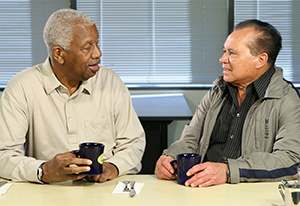Adjusting to Wearing a Hearing Aid
A hearing aid is an aid to better hearing. It's not a cure for hearing loss. People often have unrealistic hopes about their hearing aid. They are disappointed when it doesn't give them perfect hearing. Getting the most out of your new hearing aid means learning new skills.
 |
| A quiet conversation with a friend is a good place to start. |
Adjusting to a new world of sound
-
In the first week with your hearing aid, you’ll be listening to the many strange, often loud, new sounds around you, including your own voice.
-
Start with quiet, one-to-one chats with friends and family. Slowly move to more difficult situations, such as talking with more than one person.
-
Realize that adjusting to the noise in restaurants, auditoriums, and parties will take time.
-
Hearing loss often occurs slowly. Adjusting to your new hearing aid also takes time. It may take up to 6 months for you to achieve the full benefits offered by your hearing aid.
-
If you have questions about the hearing aid or have any ear discomfort, contact your audiologist.
Tips for better listening
-
Start the conversation. Don’t wait for others to speak to you first.
-
Move closer and position yourself so that the speaker’s face is well lighted and you can see it clearly.
-
Watch the speaker’s face, lips, and gestures for clues to what’s being said.
-
Relax. Don’t strain to hear every word. People with normal hearing miss words and “fill in” the meaning from surrounding sentences.
-
Ask for support from your family and friends during your adjustment period.
-
Get a telephone amplifier.
-
Wear your hearing aid. The more you use it, the better your results will be.
Online Medical Reviewer:
Ashutosh Kacker MD
Online Medical Reviewer:
Marianne Fraser MSN RN
Online Medical Reviewer:
Melinda Murray Ratini DO
Date Last Reviewed:
12/1/2024
© 2000-2025 The StayWell Company, LLC. All rights reserved. This information is not intended as a substitute for professional medical care. Always follow your healthcare professional's instructions.